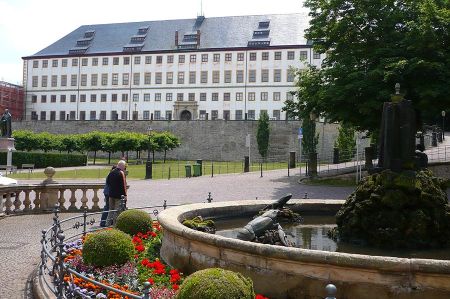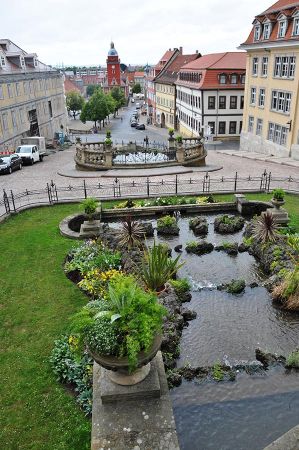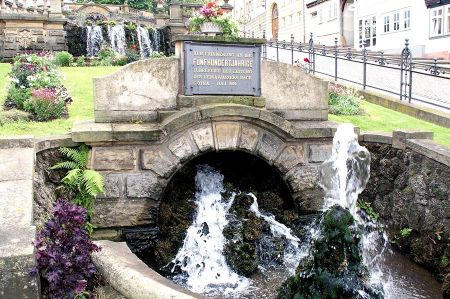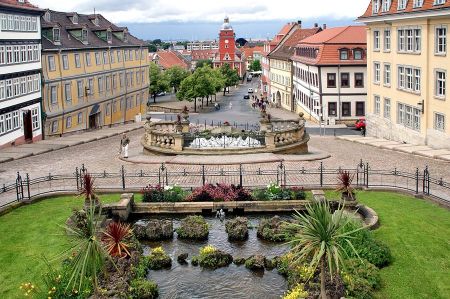The waterworks in Gotha: A jewel of engineering art
- Written by Portal Editor
The waterworks in Gotha is an outstanding example of historical engineering art and an important landmark of the Thuringian city of Gotha.
Once built to supply water to Friedenstein Castle, the building today fascinates with its combination of technology and aesthetics. In this article we take a look at the history, significance and current experience of the waterworks in Gotha.
History of the Gotha waterworks
 With the growing population of Gotha and in view of frequent fires, the city's wells no longer met the requirements, so in the 15th century the so-called Leina Canal was built, which supplied the city with water from the Thuringian Forest over a distance of around 30 km and with a height difference of 101 m. A wooden pumping station in the city was able to transport the water to Friedenstein Castle, which was built in the 17th century. At the time, Friedenstein Castle was the largest castle of the early Baroque period in Germany. To supply the castle and the surrounding gardens with water, the first waterworks was put into operation in 1655 as a technical masterpiece. It was used to transport water from a spring up to the castle hill, a task that would hardly have been possible without the innovations of the time. Over the years, this developed into an extensive pipeline system to supply water to the ducal facilities, buildings, apartments, ponds and fountains. The Leina Canal water also powered numerous mills and flowed through the middle of the city. There, at the upper end of the main market, directly below the castle, the Bergmühle on the castle hill had stood since 1387.
With the growing population of Gotha and in view of frequent fires, the city's wells no longer met the requirements, so in the 15th century the so-called Leina Canal was built, which supplied the city with water from the Thuringian Forest over a distance of around 30 km and with a height difference of 101 m. A wooden pumping station in the city was able to transport the water to Friedenstein Castle, which was built in the 17th century. At the time, Friedenstein Castle was the largest castle of the early Baroque period in Germany. To supply the castle and the surrounding gardens with water, the first waterworks was put into operation in 1655 as a technical masterpiece. It was used to transport water from a spring up to the castle hill, a task that would hardly have been possible without the innovations of the time. Over the years, this developed into an extensive pipeline system to supply water to the ducal facilities, buildings, apartments, ponds and fountains. The Leina Canal water also powered numerous mills and flowed through the middle of the city. There, at the upper end of the main market, directly below the castle, the Bergmühle on the castle hill had stood since 1387.
The technology behind the waterworks
 After the Bergmühle there was demolished in May 1895, the new waterworks (water features) were built from its stones and ceremoniously inaugurated on October 15, 1895. The new pumping station (New Waterworks) in the basement of the Lucas Cranach House, which is located on the upper main market (Markt 17) in Gotha, is still in operation today. The proposal to renovate it was made by Hugo Mairich in 1890. The Gotha machine factory Briegleb & Hansen installed a pump and turbine system in the basement of the Lucas Cranach House to operate the fountains and generate electricity. A turbine uses the water from the Leina Canal to drive a generator to generate electricity and additional pumps that still pump the water up to the castle hill today. The system in the basement of the building is in operation almost unchanged to this day and feeds Gotha's fountains and water features. In 1995, the pump system including the waterworks was restored. It can be visited.
After the Bergmühle there was demolished in May 1895, the new waterworks (water features) were built from its stones and ceremoniously inaugurated on October 15, 1895. The new pumping station (New Waterworks) in the basement of the Lucas Cranach House, which is located on the upper main market (Markt 17) in Gotha, is still in operation today. The proposal to renovate it was made by Hugo Mairich in 1890. The Gotha machine factory Briegleb & Hansen installed a pump and turbine system in the basement of the Lucas Cranach House to operate the fountains and generate electricity. A turbine uses the water from the Leina Canal to drive a generator to generate electricity and additional pumps that still pump the water up to the castle hill today. The system in the basement of the building is in operation almost unchanged to this day and feeds Gotha's fountains and water features. In 1995, the pump system including the waterworks was restored. It can be visited.
The lovingly designed outdoor area now represents a three-part water feature and fountain system that has been one of the city's most important sights since it was built. It is not in operation during the winter months. Its ceremonial opening takes place on the first weekend in May on the occasion of the Gothardus Festival.
The waterworks in Gotha used a complex system of pumps and pipes to transport the water over several kilometres and meters in altitude. A continuous flow of water could be generated using water wheels that were driven by the water of the Leina. This impressive mechanism was not only functional, but also an architectural marvel.
Architectural and aesthetic aspects
 The water flows from the fountain on Friedrich-Jacobs-Straße towards NNW over three levels with a length of around 72 m. The water falls over a waterfall into the next level with several identical ponds at different heights. The water is then led under a short dead-end road to the lower part. Here a memorial plaque from 1869 commemorates the 500th anniversary of the pipe of the Leina water to Gotha.
The water flows from the fountain on Friedrich-Jacobs-Straße towards NNW over three levels with a length of around 72 m. The water falls over a waterfall into the next level with several identical ponds at different heights. The water is then led under a short dead-end road to the lower part. Here a memorial plaque from 1869 commemorates the 500th anniversary of the pipe of the Leina water to Gotha.
In addition to its technical achievement, the waterworks is also impressive due to its aesthetics. It is embedded in the picturesque surroundings of the castle park and is decorated with stone ornaments and figures that reflect the architectural style of the time. The fountain and the various water features in particular blend harmoniously into the landscape and create an idyllic atmosphere.
The role of the waterworks in Friedenstein Castle Park
The waterworks played a central role in the design of Friedenstein Castle Park. The park itself is a magnificent example of baroque garden art, and the water brought about by the waterworks enabled the operation of fountains, ponds and other water features. Today, the park offers a quiet retreat and a wonderful view of the historic waterworks.
Restoration and preservation of the waterworks
Like many historic buildings, the Gotha waterworks has suffered damage over the years. In recent decades, extensive restoration work has been carried out to preserve the facility for posterity. The restorations place emphasis on preserving the original technology and materials in order to ensure the authenticity of the building.
The waterworks today: an experience for visitors
Today, the Gotha waterworks is a popular excursion destination and a sight for technology and history lovers. A visit not only offers an insight into the function and technology of the waterworks, but also into the life and challenges of the time. During guided tours, the mechanics are explained and visitors can view the original parts of the waterworks up close.
Events and special tours
In summer, the waterworks offers special events where the machines are put back into operation so that visitors can experience the interaction of the historical technology up close. Night tours are also very popular, as the building creates a very special atmosphere at dusk.
Why the waterworks is an important cultural asset
The waterworks in Gotha is not only a technical monument, but also a testament to the innovative power and ingenuity of people in the 17th century. It shows how challenging tasks were solved hundreds of years ago and how art and technology can be combined.
Conclusion
 Since the middle of the 19th century, the joint-stock company for the water supply of the city of Gotha transported spring water from the Mittelwassergrund (south of Tambach-Dietharz) to an elevated tank on the Hirzberg between Wipperoda and Wannigsroda and in a closed pipeline to Gotha. Hugo Mairich began planning the redesign of the castle hill and the construction of the waterworks and pumping station as early as 1890. His plans included a system that would channel the water of the Leina Canal from the castle to the main market via fountains, jets, waterfalls and whirlpools.
Since the middle of the 19th century, the joint-stock company for the water supply of the city of Gotha transported spring water from the Mittelwassergrund (south of Tambach-Dietharz) to an elevated tank on the Hirzberg between Wipperoda and Wannigsroda and in a closed pipeline to Gotha. Hugo Mairich began planning the redesign of the castle hill and the construction of the waterworks and pumping station as early as 1890. His plans included a system that would channel the water of the Leina Canal from the castle to the main market via fountains, jets, waterfalls and whirlpools.
The Gotha waterworks is a fascinating monument and a valuable connection between history, technology and art. A visit is worthwhile for anyone who is interested in the historical masterpieces of human engineering and wants to enjoy the picturesque backdrop of Friedenstein Castle Park.
FAQs about the Gotha waterworks
1. What is the waterworks in Gotha?
The waterworks in Gotha is a historical water supply system that originally supplied Friedenstein Castle with water.
2. When was the waterworks built?
The waterworks was put into operation in 1655.
3. Can you visit the waterworks?
Yes, visitors can visit the waterworks and take part in guided tours.
4. What technology was used in the waterworks?
It uses water wheels and a complex pumping system to transport water up the castle hill.
5. Are there special events at the waterworks?
Yes, in the summer there are special events and night tours where the technology is shown in action.
Please read as well:
At the waterworks: Wismar - a place for culinary experiences
